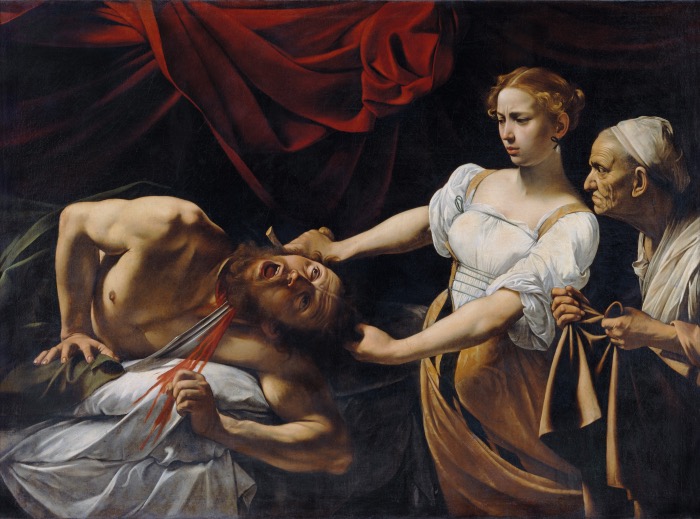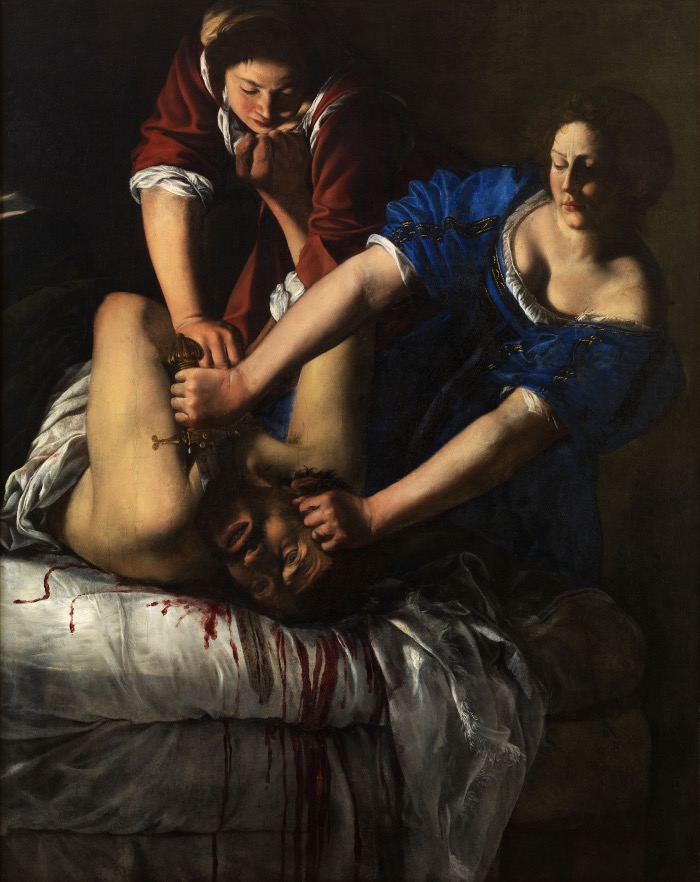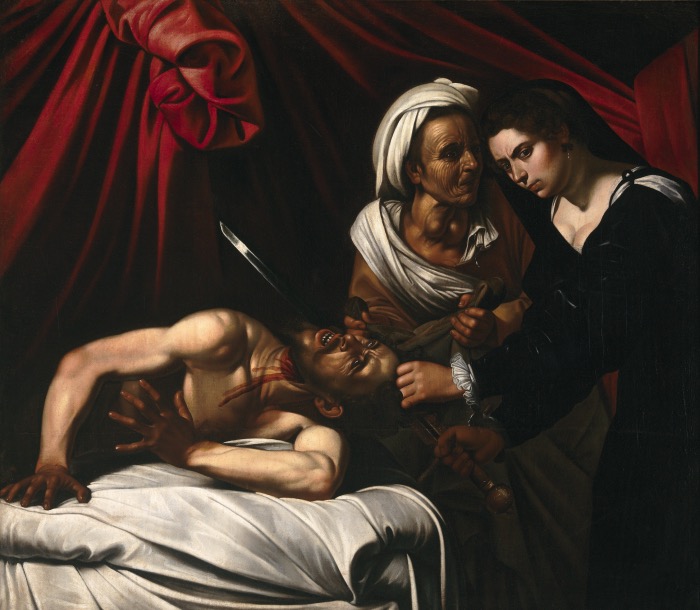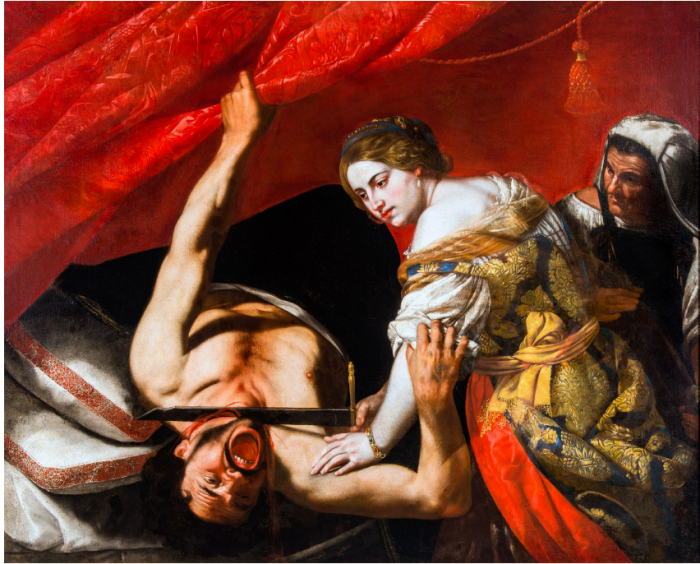Judith Beheading Holofernes by Caravaggio

Michelangelo Merisi detto Caravaggio (Milano, 1571 – Porto Ercole, 1610) Giuditta decapita Oloferne, 1599 circa. Olio su tela, cm 145×195. Roma, Gallerie Nazionali di Arte Antica – Palazzo Barberini
JUDITH DECAPITATING HOLOFERNES BY CARAVAGGIO
Caravaggio’s Judith Beheading Holofernes is one of Michelangelo Merisi’s masterpieces and one of the most important works of the 17th century.
The work belonged to the banker Ottavio Costa, one of the most famous and wealthy figures in early 17th-century Rome.
Ottavio Costa was so proud of his ownership of Caravaggio’s Judith Beheading Holofernes that he forbade its sale even after his death and discouraged any copies from being made.
Nonetheless, the painting was a huge success among the artists of the time and became a powerful model for the new iconography of the famous biblical heroine.
Judith Beheading Holofernes by Caravaggio

Artemisia Gentileschi (Roma, 1593 – Napoli?, post 1654) Giuditta decapita Oloferne, 1612 circa. Olio su tela, cm 159×126. Napoli, Museo e Real Bosco di Capodimonte
Caravaggio’s Judith Beheading Holofernes is part of the collection of works in the Galleria di Arte Antica in Palazzo Barberini in Rome. It is probably the most famous
of Caravaggio’s works and has become, through its strength and beauty, part of the collective imagination.
However, few people know that the painting, made for the Ligurian banker Ottavio Costa, one of the most passionate Caravaggio collectors in Rome, had a very low profile in the 17th century, being among the works that Costa jealously guarded, so much so that no real antique copies are known.
The canvas stages a heinous murder.
As narrated in the Book of Judith, a courageous widow from the city of Bethulia managed to save the Jewish people from the tyranny of the Assyrians by beheading the fearsome general Holofernes who, seduced by the woman’s charm, had fallen asleep drunk after a banquet organised in her honour.
Caravaggio depicts the beheading of Holofernes as a theatrical drama in which we are the spectators.
The work was a turning point in the collective imagination of its time as it described a real heroine. An example of a virtuous woman in seventeenth-century Rome.
The scene depicted in Caravaggio’s Judith Beheading Holofernes is gory and looks almost like a visual chronicle of a murder perpetrated live by a beautiful but deadly Judith.
In the eyes of Caravaggio’s contemporaries, the image could not but appear revolutionary, compared with earlier versions of the theme, in which the woman displays the head of Holofernes, to seal the happy ending of a concluded enterprise.
The canvas, painted in 1599 by Caravaggio for the Ligurian banker Ottavio Costa, who died in 1639, remained in Rome until the mid-nineteenth century, when it passed into the ownership of the banker, and then became part of the heritage of the Gallerie Nazionali di Arte Antica in Rome in 1971.
Extremely jealous of the work, Costa forbade not only its sale but also its reproduction, which is why there are no faithful 17th-century copies, a rare occurrence in the history of the fortunes of Caravaggio’s works.
Despite the owner’s caution, the revolutionary composition conceived by Merisi nevertheless managed to circulate.

Louis Finson (attribuito) (Bruges, ante 1580 – Amsterdam, 1617) Giuditta decapita Oloferne, post 1607. Olio su tela, cm 140×161. Collezione Intesa Sanpaolo
CURIOSITIES ABOUT CARAVAGGIO’S JUDITH BEHEADING HOLOFERNES
Caravaggio painted another version of the theme of Judith Beheading Holofernes.
This work was offered for sale in Naples in 1607 but has now disappeared. However, it is remembered in a painting attributed to Luis Finson, who was already familiar with Caravaggio and his work in Rome, where he lived in 1600.
It was perhaps the Neapolitan painting, as yet unidentified, that decreed the greatest fortune of Caravaggio’s invention, which found in Naples, among others, a very elegant interpreter in Filippo Vitale, almost thirty years after Merisi’s death.
Artemisia Gentileschi is perhaps the most original and passionate interpreter of Merisi’s masterpiece, with which she returned several times to measure herself, in a profound and personal reflection on the concentrated, essential theatricality of the theme of Judith and Holofernes. In the Capodimonte canvas, probably painted in Rome around 1612, Artemisia stages the murder as Caravaggio had done, but with a harsher ferocity, perhaps an obscure visual trace of a dramatic personal experience.

Filippo Vitale (Napoli 1589 circa – 1650), Giuditta decapita Oloferne, post 1637. Olio su tela, cm 126×154. Montpellier Méditerranée Métropole, Musée Fabre
EXHIBITION DEDICATED TO CARAVAGGIO’S JUDITH BEHEADING HOLOFERNES
The Gallerie Nazionali di Arte Antica presents from 26 November 2021 to 27 March 2022 the exhibition “Caravaggio and Artemisia: the challenge of Judith. Violence and seduction in sixteenth- and seventeenth-century painting”, curated by Maria Cristina Terzaghi.
The exhibition, hosted in the exhibition space of Palazzo Barberini, turns the spotlight on the famous painting by Caravaggio seventy years after its rediscovery and fifty years after its acquisition by the Italian State.
Caravaggio and Artemisia: The Challenge of Judith. Violence and seduction in sixteenth- and seventeenth-century painting26
November 2021 – 27 March 2022
National Galleries of Ancient Art – Palazzo Barberini, Rome
One of Merisi’s most famous and acclaimed works, thanks to the power of its representation and the strength emanating from the three protagonists, Judith was rediscovered in 1951 by Pico Cellini, one of the greatest restorers of the 20th century.
The exhibition is accompanied by the catalogue “Caravaggio and Artemisia: the challenge of Judith” published by Officina Libraria, with a text by the curator, which explores the history of Caravaggio’s Judith and that of Artemisia Gentileschi, recording the effects of the two masterpieces on contemporary painting.
HOW TO SEE THE WORK
Caravaggio’s Judith Beheading Holofernes is housed and exhibited at the Galleria di Arte Antica di Palazzo Barberini in Rome.
To book your ticket select a date from the calendar.
Follow me on:
About me
In this blog, I don't explain the history of art — I tell the stories that art itself tells.


